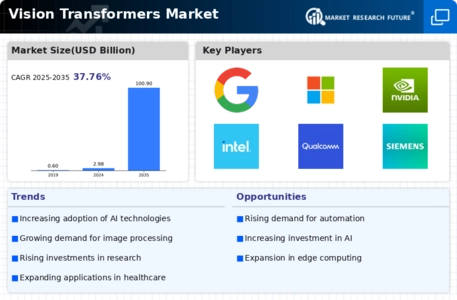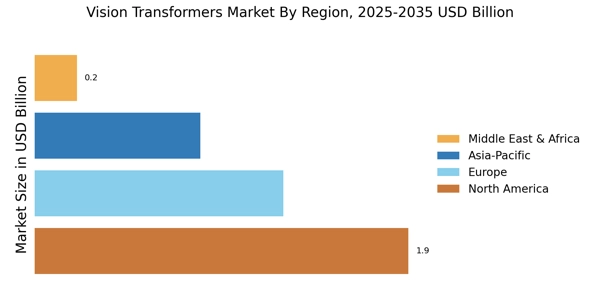Rising Demand for Advanced AI Solutions
The Vision Transformers Market is experiencing a notable surge in demand for advanced artificial intelligence solutions. Organizations across various sectors are increasingly recognizing the potential of vision transformers to enhance image recognition and processing capabilities. This trend is particularly evident in industries such as automotive, where the integration of vision transformers into autonomous driving systems is becoming commonplace. According to recent estimates, the market for AI-driven image processing is projected to reach USD 25 billion by 2026, indicating a robust growth trajectory. As businesses seek to leverage AI for competitive advantage, the Vision Transformers Market is poised to benefit significantly from this growing demand.
Expansion of Computer Vision Applications
The Vision Transformers Market is witnessing an expansion in the applications of computer vision technologies. Industries such as retail, security, and agriculture are increasingly adopting vision transformers to improve operational efficiency and decision-making processes. For instance, in retail, vision transformers are utilized for inventory management and customer behavior analysis, enhancing the shopping experience. The market for computer vision is expected to grow at a compound annual growth rate of 20% over the next five years, reflecting the increasing reliance on visual data analysis. This trend underscores the pivotal role of vision transformers in driving innovation within the Vision Transformers Market.
Technological Advancements in Deep Learning
Technological advancements in deep learning are significantly influencing the Vision Transformers Market. The development of more sophisticated algorithms and architectures has enabled vision transformers to outperform traditional convolutional neural networks in various tasks. This shift is particularly relevant in fields such as medical imaging, where accuracy and precision are paramount. As research continues to evolve, the capabilities of vision transformers are expected to expand, potentially leading to new applications and use cases. The increasing investment in AI research and development is likely to further propel the Vision Transformers Market, as organizations seek to harness these advancements for improved outcomes.
Growing Investment in Smart City Initiatives
The Vision Transformers Market is benefiting from the growing investment in smart city initiatives. As urban areas strive to enhance infrastructure and public services, the integration of vision transformers into surveillance and traffic management systems is becoming increasingly prevalent. These technologies enable real-time monitoring and analysis, contributing to improved safety and efficiency in urban environments. With governments and private entities allocating substantial resources to smart city projects, the demand for vision transformers is expected to rise. This trend not only supports the Vision Transformers Market but also aligns with broader goals of urban sustainability and innovation.
Increased Focus on Data Privacy and Security
The Vision Transformers Market is also influenced by the increased focus on data privacy and security. As organizations adopt vision transformers for various applications, concerns regarding the ethical use of data and compliance with regulations are becoming paramount. This has led to the development of more secure and privacy-conscious AI solutions, which are essential for gaining consumer trust. The market is likely to see a rise in demand for vision transformers that incorporate robust security features, ensuring that data is handled responsibly. This emphasis on privacy and security could shape the future landscape of the Vision Transformers Market, driving innovation and compliance.


















Leave a Comment